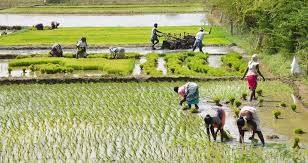Paddy production likely to be hit in U.P. as 35 districts face rain deficit
Rice production in Uttar Pradesh may get affected this year as the state has achieved only 88% of the paddy sowing target so far even as the sowing season for Kharif season has almost ended, people in the know of things said.
The situation arises from uneven and deficit rainfall in most parts of the state which overall received 112% of the normal rainfall between June and August even as 35 of the 75 districts are still struggling with deficient rainfall.
According to a recent report prepared by the agriculture department, paddy plantation in the state has been done on 88% of the targeted land area. Similarly, the total sowing of all Kharif crops, including millets, maize, pulses, groundnut etc is even lower at 84%.
Former agriculture director (statistics) Rajesh Gupta said, “Plantation of paddy comes to end by July end and any planation after that affects the quality due to change in the weather.” He said both productivity and production of the rice were expected to be lower this year because of uneven and deficit rainfall in many districts.
“Paddy is such a crop that cannot survive without adequate rain,” Gupta pointed out. The report shows that the rainfall is deficient in 15 districts, highly deficient in another 16 districts and scanty (below 40% of the normal) in four districts.
The districts receiving the least rainfall since June are Amethi, Fatehpur, Gautam Buddh Nagar and Shamli. As many as 15 districts have received excessive rain, that is above 120% of the normal and only 25 districts have received normal rain.
Among the four economic zones, the central and the eastern zones have received the least rain at 73.3% and 84.6% of the normal rainfall.
Given the water scarcity, the government has advised farmers to consider switching to alternative crops that require less water, aiming to mitigate the impact of the delayed monsoon. The government is also providing subsidies on the seeds of such crops.
This article has been republished from The Times of India.

